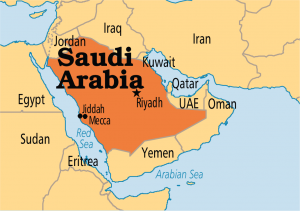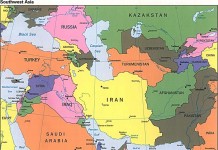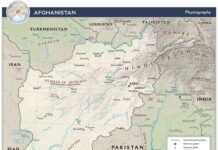Great Power Rivalry in the Middle E ast – What it means for South Asia?
ast – What it means for South Asia?
Context
The New Cold War paradigm and great power rivalry framework is settling in and beginning to define international affairs. After Europe and Pacific, Middle East is emerging as another hotly contested theater between the global powers. While Ukraine has been consuming most of the media bandwidth, matters related to Iran’s nuclear program and Israeli-Palestinian conflict had taken more of a back seat. Nonetheless, after the War Against Terror, Ukraine has become the new pivot increasingly defining geopolitics, and meanwhile galvanizing NATO and EU.
President Biden’s visit to Israel and Palestinian territories in July, and then to Saudi Arabia, signaled that US aspires to reinvigorate its traditional ties with the Arab world – as it attempts to harness their support against Russia and China. And this was stated by none other than the President himself while speaking to the GCC during his visit to Saudi Arabia,
“We will not walk away and leave a vacuum to be filled by China, Russia or Iran … We will seek to build on this moment with active, principled, American leadership.”
US withdrawal from Iraq in 2011, and from Afghanistan in 2021, gave the impression that America was no longer interested in the Middle East – a perception that was reinforced by mantras such as ‘Pivot to Asia’ used during the Obama administration (2009-2017). Moreover, Iran nuclear deal (also known as JCPOA) reached in July 2015 had greatly unnerved the Israelis and the Gulf States regarding the balance of power in the region and US intent.
After coming to power, one of the first nation visited by former president Trump in 2017 was Saudi Arabia. However, he withdrew from the Iran nuclear deal in 2018. During his tenure, US once again established cordial ties with Israel that have been damaged during the Obama presidency. One of the common themes that brought the Arabs and Israel closer has been the expanding influence of Iran in the region. Trump also applied maximum pressure on Iran. In a drone strike in January 2020, Iranian intelligence chief Qasem Soleimani was eliminated in Baghdad. On the other hand, Israel also kept the pressure on the country to stall its nuclear ambitions. The chief of Iran’s nuclear program, Mohsen Fakhrizadeh, was assassinated in November 2020.
In parallel and on the diplomatic front, Trump administration worked towards improving ties between the Arabs and Israel, which culminated in Abraham Accords in August 2020. As a result, UAE, Bahrain, and subsequently Sudan and Morocco, also normalized ties with Israel. It was believed that Saudi Arabia will also soon follow, and according to some analysts, other key non-Arab nations, like Pakistan, are also being pressured towards this reorientation of the regional threat perception. The other key Muslim state, Turkey, already has normal ties with Israel.
Revitalized NATO
While Trump was exerting pressure on Iran, pulling out of the nuclear deal also alienated American European allies who had strived greatly to secure the deal. Moreover, not contributing enough towards NATO has also been a persistent source of tension between the US and its European allies. The Ukraine crisis has helped reverse this while attracting new aspirants, like Sweden and Finland, for NATO membership. Just before travelling to the Middle East, Biden was in Europe attending the NATO and G7 gatherings. One of the top-most agenda during the NATO meetings was to come up with a new concept that unites and define the NATO alliance for the future. NATO’s updated mission statement for the first time mentions Russia as the greatest threat and China-Russian alliance as a counter to its values.
While NATO looks to thwart Russia in Ukraine, Middle East represents the other flank. There is less consensus on how much time and resources it will take to achieve the goals in Ukraine and elsewhere. Disruption of supply chains and rising energy costs are some of the direct consequences of the conflict, including inflation, when nations were just beginning to come out of Covid-19 induced economic woes.
China- Russia and Middle East
China and Russia both have been extending their influence in the Middle East. The $400 billion China–Iran treaty signed in March 2021 must have been an ominous development from the perspective of the Gulf Arabs and the US. However, the talks have been proceeding for a while, as has been the ‘Outside-In Approach’ to the Arab-Israeli conflict.
Through its Belt and Road Initiative (BRI), China has become an active player in the Middle East with strategic ties with a number of regional players, to include Saudi Arabia. As its influence increases gradually, it could become an active interlocutor between Israel and the Palestinians, and other conflicts of the Middle East. However, it’s not clear if China desires to get involved in the security affairs of the region, like Russia has in Syria – as far as the Middle East is concerned. Soon after Biden’s visit to the Middle East, Putin and Erdogan visited Iran and discussed the evolving situation in Syria, and allowing shipment of Ukrainian grain through the Black Sea. According to media reports, Khamenei called for long-term cooperation between Russia and Iran and to guard against ‘Western deception’.
Chinese analysts present a case the nation wants to be more involved in providing economic support than engaging in the security affairs of the Middle East. Nonetheless, it has good political and military relations with both Iran and Israel. As part of BRI, China has been extending its trade relations with Israel and lately US has objected strongly to some of them citing security concerns – such as the Shanghai International Port Group (SIPG) running a container terminal at the Port of Haifa – near an Israeli naval base that is frequently visited by the US Sixth Fleet. The Secretary of State Mike Pompeo had warned Israel in 2019 to reduce its economic and security ties with China or risk reduced security cooperation from US.
If the China-Israeli economic ties are allowed to strengthen uninhibited, overtime China will be able to build leverages that can potentially undercut US primacy in the affairs of the Middle East. The Israelis disagree on this, stating the nature of its ties with China and the US are of totally different nature.
Conclusion
Thus, Biden’s visit to Saudi Arabia represents a push to counter China and Russia and meanwhile providing continuity to the policy undertaken by Trump, which resulted in Abraham Accords. At the same time, engaging and supporting the Palestinian authorities, and reiterating that two-state solution remains the best way forward to resolving the conflict.
The fresh engagement also envisions a new security architecture for the region that some have called the Arab NATO. During the G7 meeting held in the Bavarian Alps, the leaders also announced the $600 billion Partnership for Global Infrastructure and Investment program, seen as an alternative to Chinese BRI.
With their energy resources UAE, Qatar, and Saudi Arabia, have also come to play an increasingly critical role when it comes to the affairs South Asia, most recently exhibited in Afghanistan. Then there are the expanding Indian ties with the Gulf nations that have overshadowed the traditional Pakistan’s influence. And this change has undercut the financial support from the region Pakistan had relied upon in the past. PoliTact had covered this shift in a joint event with the Middle East Institute in November 2018.
The reoriented US engagement with the Arab world will also have a profound impact on the affairs of South Asia – and the present political and economic turbulence in Pakistan could be the direct result of this flux in Middle East – and surge of great power tussles there.



